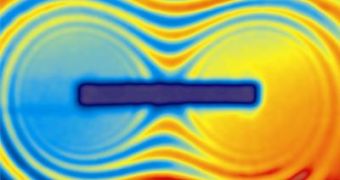Magnetic fields are routinely used in medical and scientific investigations to make observations of internal structures. For the first time researchers were able to create a three-dimensional of a magnetic field inside a solid, non-transparent structure through a technique using neutron polarization. The study was conducted by Nikolay Kardjilov from the University of Applied Sciences in collaboration with Hahn-Meitner-Institute.
Neutrons are subatomic particles carrying zero electrical charge, meaning that they are not affected by electrical fields. However, they do carry internal angular momentum and magnetic momentum, thus they can be used to make investigations into magnetic phenomenons inside magnetic materials. The magnetic momentum always points in the direction of the magnetic field through which particles pass.
The angular momentum is best known to us as spin, because fundamental particles rotate around their axis much in the same way our planet rotate on its own axis. The polarization phenomenon takes place when all magnetic moments of the particles point towards the same direction. What happens is that the magnetic moments of the neutrons will start to rotate around the magnetic fields in the magnetic object, thus changing the spin direction.
The spin polarization of particles is a measurable phenomenon, meaning that the spin direction of a neutron can be precisely detected in order to measure changes in spin and to actually view how a magnetic field looks like inside a magnetic object.
Kardjilov reveals that the procedure is much like a X-ray CT scan, when a sample is shined with X-ray light to reveal the density of materials inside it. "It's the same with our magnetic specimen, which changes the spin rotation of the neutrons. The equipment only allows passage of neutrons with a specific spin rotation, and this generates the contrast according to how the magnetic properties are distributed within the specimen. By rotating the specimen we can reconstruct a three-dimensional image," said Kardjilov.
The technique was first used by Kardjilov back in 2005, when he produced a three-dimensional image of a magnetic field by measuring the spin rotation of neutrons. Contrast is produced with different levels of absorption of radiation by different materials. HMI researchers make use of magnetism to study the materials such as high temperature superconductivity and to understand how magnetic flux lines are distributed and established inside a specific material. The innovation brought by the HMI team now also allows to view magnetic domains in a three-dimensional image.

 14 DAY TRIAL //
14 DAY TRIAL //